Dazhong Shen
ADT: Tuning Diffusion Models with Adversarial Supervision
Apr 15, 2025Abstract:Diffusion models have achieved outstanding image generation by reversing a forward noising process to approximate true data distributions. During training, these models predict diffusion scores from noised versions of true samples in a single forward pass, while inference requires iterative denoising starting from white noise. This training-inference divergences hinder the alignment between inference and training data distributions, due to potential prediction biases and cumulative error accumulation. To address this problem, we propose an intuitive but effective fine-tuning framework, called Adversarial Diffusion Tuning (ADT), by stimulating the inference process during optimization and aligning the final outputs with training data by adversarial supervision. Specifically, to achieve robust adversarial training, ADT features a siamese-network discriminator with a fixed pre-trained backbone and lightweight trainable parameters, incorporates an image-to-image sampling strategy to smooth discriminative difficulties, and preserves the original diffusion loss to prevent discriminator hacking. In addition, we carefully constrain the backward-flowing path for back-propagating gradients along the inference path without incurring memory overload or gradient explosion. Finally, extensive experiments on Stable Diffusion models (v1.5, XL, and v3), demonstrate that ADT significantly improves both distribution alignment and image quality.
Boosting Knowledge Graph-based Recommendations through Confidence-Aware Augmentation with Large Language Models
Feb 06, 2025



Abstract:Knowledge Graph-based recommendations have gained significant attention due to their ability to leverage rich semantic relationships. However, constructing and maintaining Knowledge Graphs (KGs) is resource-intensive, and the accuracy of KGs can suffer from noisy, outdated, or irrelevant triplets. Recent advancements in Large Language Models (LLMs) offer a promising way to improve the quality and relevance of KGs for recommendation tasks. Despite this, integrating LLMs into KG-based systems presents challenges, such as efficiently augmenting KGs, addressing hallucinations, and developing effective joint learning methods. In this paper, we propose the Confidence-aware KG-based Recommendation Framework with LLM Augmentation (CKG-LLMA), a novel framework that combines KGs and LLMs for recommendation task. The framework includes: (1) an LLM-based subgraph augmenter for enriching KGs with high-quality information, (2) a confidence-aware message propagation mechanism to filter noisy triplets, and (3) a dual-view contrastive learning method to integrate user-item interactions and KG data. Additionally, we employ a confidence-aware explanation generation process to guide LLMs in producing realistic explanations for recommendations. Finally, extensive experiments demonstrate the effectiveness of CKG-LLMA across multiple public datasets.
A Comprehensive Survey on Self-Interpretable Neural Networks
Jan 26, 2025Abstract:Neural networks have achieved remarkable success across various fields. However, the lack of interpretability limits their practical use, particularly in critical decision-making scenarios. Post-hoc interpretability, which provides explanations for pre-trained models, is often at risk of robustness and fidelity. This has inspired a rising interest in self-interpretable neural networks, which inherently reveal the prediction rationale through the model structures. Although there exist surveys on post-hoc interpretability, a comprehensive and systematic survey of self-interpretable neural networks is still missing. To address this gap, we first collect and review existing works on self-interpretable neural networks and provide a structured summary of their methodologies from five key perspectives: attribution-based, function-based, concept-based, prototype-based, and rule-based self-interpretation. We also present concrete, visualized examples of model explanations and discuss their applicability across diverse scenarios, including image, text, graph data, and deep reinforcement learning. Additionally, we summarize existing evaluation metrics for self-interpretability and identify open challenges in this field, offering insights for future research. To support ongoing developments, we present a publicly accessible resource to track advancements in this domain: https://github.com/yangji721/Awesome-Self-Interpretable-Neural-Network.
Hierarchical Time-Aware Mixture of Experts for Multi-Modal Sequential Recommendation
Jan 24, 2025Abstract:Multi-modal sequential recommendation (SR) leverages multi-modal data to learn more comprehensive item features and user preferences than traditional SR methods, which has become a critical topic in both academia and industry. Existing methods typically focus on enhancing multi-modal information utility through adaptive modality fusion to capture the evolving of user preference from user-item interaction sequences. However, most of them overlook the interference caused by redundant interest-irrelevant information contained in rich multi-modal data. Additionally, they primarily rely on implicit temporal information based solely on chronological ordering, neglecting explicit temporal signals that could more effectively represent dynamic user interest over time. To address these limitations, we propose a Hierarchical time-aware Mixture of experts for multi-modal Sequential Recommendation (HM4SR) with a two-level Mixture of Experts (MoE) and a multi-task learning strategy. Specifically, the first MoE, named Interactive MoE, extracts essential user interest-related information from the multi-modal data of each item. Then, the second MoE, termed Temporal MoE, captures user dynamic interests by introducing explicit temporal embeddings from timestamps in modality encoding. To further address data sparsity, we propose three auxiliary supervision tasks: sequence-level category prediction (CP) for item feature understanding, contrastive learning on ID (IDCL) to align sequence context with user interests, and placeholder contrastive learning (PCL) to integrate temporal information with modalities for dynamic interest modeling. Extensive experiments on four public datasets verify the effectiveness of HM4SR compared to several state-of-the-art approaches.
EasyRef: Omni-Generalized Group Image Reference for Diffusion Models via Multimodal LLM
Dec 12, 2024



Abstract:Significant achievements in personalization of diffusion models have been witnessed. Conventional tuning-free methods mostly encode multiple reference images by averaging their image embeddings as the injection condition, but such an image-independent operation cannot perform interaction among images to capture consistent visual elements within multiple references. Although the tuning-based Low-Rank Adaptation (LoRA) can effectively extract consistent elements within multiple images through the training process, it necessitates specific finetuning for each distinct image group. This paper introduces EasyRef, a novel plug-and-play adaptation method that enables diffusion models to be conditioned on multiple reference images and the text prompt. To effectively exploit consistent visual elements within multiple images, we leverage the multi-image comprehension and instruction-following capabilities of the multimodal large language model (MLLM), prompting it to capture consistent visual elements based on the instruction. Besides, injecting the MLLM's representations into the diffusion process through adapters can easily generalize to unseen domains, mining the consistent visual elements within unseen data. To mitigate computational costs and enhance fine-grained detail preservation, we introduce an efficient reference aggregation strategy and a progressive training scheme. Finally, we introduce MRBench, a new multi-reference image generation benchmark. Experimental results demonstrate EasyRef surpasses both tuning-free methods like IP-Adapter and tuning-based methods like LoRA, achieving superior aesthetic quality and robust zero-shot generalization across diverse domains.
Pretrained Reversible Generation as Unsupervised Visual Representation Learning
Nov 29, 2024Abstract:Recent generative models based on score matching and flow matching have significantly advanced generation tasks, but their potential in discriminative tasks remains underexplored. Previous approaches, such as generative classifiers, have not fully leveraged the capabilities of these models for discriminative tasks due to their intricate designs. We propose Pretrained Reversible Generation (PRG), which extracts unsupervised representations by reversing the generative process of a pretrained continuous flow model. PRG effectively reuses unsupervised generative models, leveraging their high capacity to serve as robust and generalizable feature extractors for downstream tasks. Our method consistently outperforms prior approaches across multiple benchmarks, achieving state-of-the-art performance among generative model-based methods, including 78\% top-1 accuracy on ImageNet. Extensive ablation studies further validate the effectiveness of our approach.
RIGL: A Unified Reciprocal Approach for Tracing the Independent and Group Learning Processes
Jun 18, 2024Abstract:In the realm of education, both independent learning and group learning are esteemed as the most classic paradigms. The former allows learners to self-direct their studies, while the latter is typically characterized by teacher-directed scenarios. Recent studies in the field of intelligent education have leveraged deep temporal models to trace the learning process, capturing the dynamics of students' knowledge states, and have achieved remarkable performance. However, existing approaches have primarily focused on modeling the independent learning process, with the group learning paradigm receiving less attention. Moreover, the reciprocal effect between the two learning processes, especially their combined potential to foster holistic student development, remains inadequately explored. To this end, in this paper, we propose RIGL, a unified Reciprocal model to trace knowledge states at both the individual and group levels, drawing from the Independent and Group Learning processes. Specifically, we first introduce a time frame-aware reciprocal embedding module to concurrently model both student and group response interactions across various time frames. Subsequently, we employ reciprocal enhanced learning modeling to fully exploit the comprehensive and complementary information between the two behaviors. Furthermore, we design a relation-guided temporal attentive network, comprised of dynamic graph modeling coupled with a temporal self-attention mechanism. It is used to delve into the dynamic influence of individual and group interactions throughout the learning processes. Conclusively, we introduce a bias-aware contrastive learning module to bolster the stability of the model's training. Extensive experiments on four real-world educational datasets clearly demonstrate the effectiveness of the proposed RIGL model.
Phased Consistency Model
May 28, 2024Abstract:The consistency model (CM) has recently made significant progress in accelerating the generation of diffusion models. However, its application to high-resolution, text-conditioned image generation in the latent space (a.k.a., LCM) remains unsatisfactory. In this paper, we identify three key flaws in the current design of LCM. We investigate the reasons behind these limitations and propose the Phased Consistency Model (PCM), which generalizes the design space and addresses all identified limitations. Our evaluations demonstrate that PCM significantly outperforms LCM across 1--16 step generation settings. While PCM is specifically designed for multi-step refinement, it achieves even superior or comparable 1-step generation results to previously state-of-the-art specifically designed 1-step methods. Furthermore, we show that PCM's methodology is versatile and applicable to video generation, enabling us to train the state-of-the-art few-step text-to-video generator. More details are available at https://g-u-n.github.io/projects/pcm/.
MoVA: Adapting Mixture of Vision Experts to Multimodal Context
Apr 19, 2024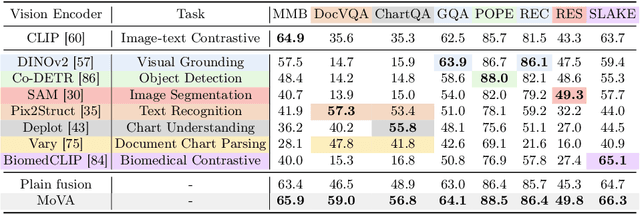
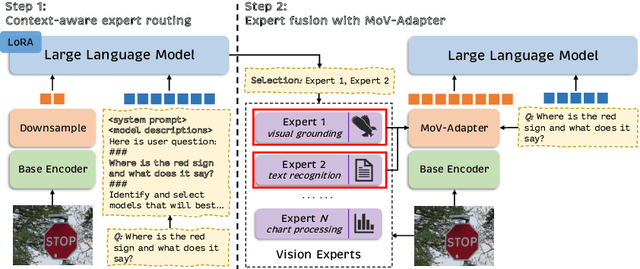
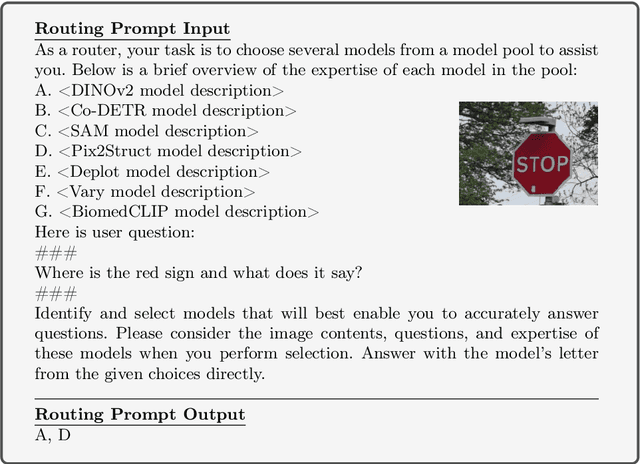
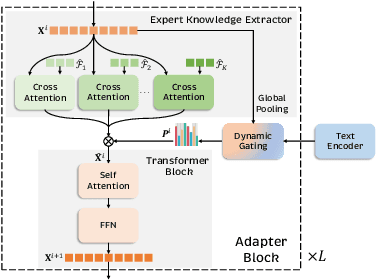
Abstract:As the key component in multimodal large language models (MLLMs), the ability of the visual encoder greatly affects MLLM's understanding on diverse image content. Although some large-scale pretrained vision encoders such as vision encoders in CLIP and DINOv2 have brought promising performance, we found that there is still no single vision encoder that can dominate various image content understanding, e.g., the CLIP vision encoder leads to outstanding results on general image understanding but poor performance on document or chart content. To alleviate the bias of CLIP vision encoder, we first delve into the inherent behavior of different pre-trained vision encoders and then propose the MoVA, a powerful and novel MLLM, adaptively routing and fusing task-specific vision experts with a coarse-to-fine mechanism. In the coarse-grained stage, we design a context-aware expert routing strategy to dynamically select the most suitable vision experts according to the user instruction, input image, and expertise of vision experts. This benefits from the powerful model function understanding ability of the large language model (LLM) equipped with expert-routing low-rank adaptation (LoRA). In the fine-grained stage, we elaborately conduct the mixture-of-vision-expert adapter (MoV-Adapter) to extract and fuse task-specific knowledge from various experts. This coarse-to-fine paradigm effectively leverages representations from experts based on multimodal context and model expertise, further enhancing the generalization ability. We conduct extensive experiments to evaluate the effectiveness of the proposed approach. Without any bells and whistles, MoVA can achieve significant performance gains over current state-of-the-art methods in a wide range of challenging multimodal benchmarks. Codes and models will be available at https://github.com/TempleX98/MoVA.
Towards Efficient Resume Understanding: A Multi-Granularity Multi-Modal Pre-Training Approach
Apr 13, 2024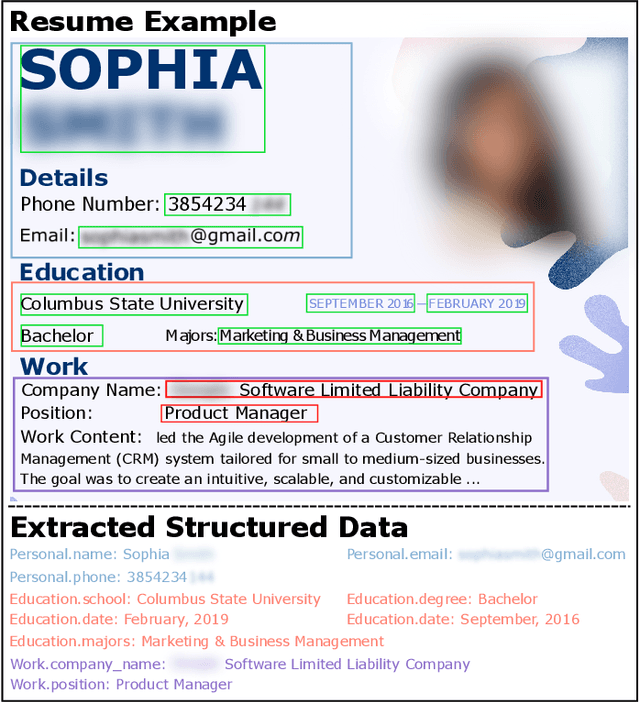
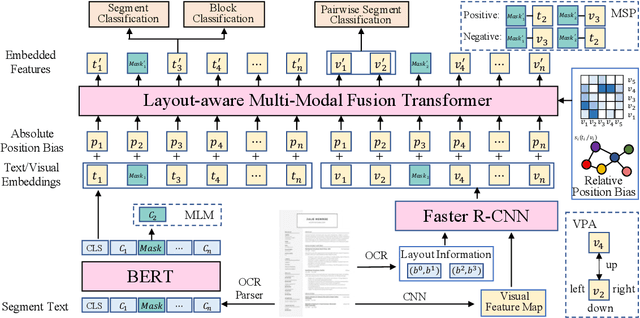


Abstract:In the contemporary era of widespread online recruitment, resume understanding has been widely acknowledged as a fundamental and crucial task, which aims to extract structured information from resume documents automatically. Compared to the traditional rule-based approaches, the utilization of recently proposed pre-trained document understanding models can greatly enhance the effectiveness of resume understanding. The present approaches have, however, disregarded the hierarchical relations within the structured information presented in resumes, and have difficulty parsing resumes in an efficient manner. To this end, in this paper, we propose a novel model, namely ERU, to achieve efficient resume understanding. Specifically, we first introduce a layout-aware multi-modal fusion transformer for encoding the segments in the resume with integrated textual, visual, and layout information. Then, we design three self-supervised tasks to pre-train this module via a large number of unlabeled resumes. Next, we fine-tune the model with a multi-granularity sequence labeling task to extract structured information from resumes. Finally, extensive experiments on a real-world dataset clearly demonstrate the effectiveness of ERU.
 Add to Chrome
Add to Chrome Add to Firefox
Add to Firefox Add to Edge
Add to Edge